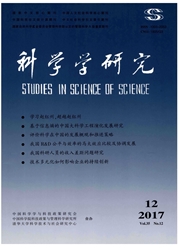

 中文摘要:
中文摘要:
科学知识网络的良性发展与繁荣演进是城市创新能力提升的重要基础。本文以2000—2015年长三角城市群论文合作数据,构建科学知识网络,分别从整体网与自我网的空间分布、拓扑特征、结构复杂性等特征,着重分析长三角城市群科学知识网络的动态演变规律与演化方向,研究发现:(1)长三角城市群科学知识整体网络结构指标间呈幂律函数关系。网络不断扩张,权度、密度、聚集系数逐年增大;(2)整体网的演进存在向“小世界”网络发展的趋势,以2008年为拐点趋势愈加明显,表现出无标度特征;(3)长三角城市自我中心网络的度分布为钟形分布,表明合作机会的均等与公平。权分布为帕累托分布表现出合作资源的集中与不均衡。网络空间分布模式呈现层级性、向多中心结构发展,科学知识合作能力具有等级扩散现象。(4)城市自我中心网是从合作型向研究型演进,是一个不断加速的进化过程。研究型城市是促进科学知识网络后期成长与进化的主要动力。
 英文摘要:
英文摘要:
Healthy development and evolution of scientific knowledge network is important to cities' innovation. This paper use the da- ta of the paper cooperation between 25 cities in the YangTze River Delta from 2000 to 2015, analysis the dynamic evolution of whole network and ego network combining the indicators of structure, spatial characteristics and complexity. Major findings include: (1) Function in the topological indicators of the whole network are power- low functions. The network is expanding, weights,density and cluster coefficient are increasing every year. (2) The trend of integrated network is evolving to "small - world" , which is more obvious after 2008 and has scale - free characteristic. (3) Nodes Degree distribution of city ego network obey the bell curve which means the fairness of cooperated chances. The nodes and edges distribution of weight are consistent with the Pareto distribution, which means the agglomeration of the cooperated resource. Spatial mode of network are hierarchical diffusion and multiple centrality structure. (4) City ego network evolve from cooperation to research. The speed of evolve will be more far. Research cities are the major power of the net- work development and evolution lately.
 同期刊论文项目
同期刊论文项目
 同项目期刊论文
同项目期刊论文
 期刊信息
期刊信息
